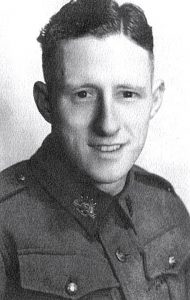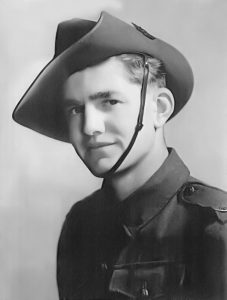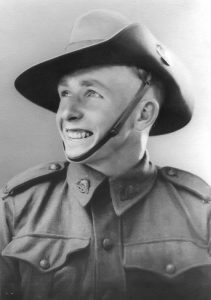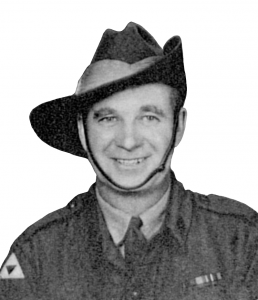KOREA
There were only five men from the 2/4th MG Battalion who managed to see the sights of Korea. Ted Roots, Jack Taylor, Jim Clancy, Bill Gray and Hubert ‘Dutchy’ Holland. They boarded the 3,829-ton passenger-cargo ship ‘Fukai Maru’ 16 August 1942. The Australian contingent of 115 men was part of a 1,000 strong work party. The remainder of this party was made up of 885 British prisoners which was designated Japan ‘B’ Party.
Please read further about Fukai Maru
These 1000 men were ‘the icing on the cake’ as the real prize was the 47 man Senior Officer’s Party. There was not an officer in this Group under the rank of full Colonel. Included were Lt-Gen A.E. Percival, the former G.O.C. Malaya, Singapore’s former Governor Sir Shenton Thomas and Brigadier Arthur Blackburn ex-Java.
This Officer Party designated simply as the ‘Special Party’ was made up to a compliment of 400 men by the inclusion of engineers and technicians. At first it was the Japanese intention that all 1400 men would be loaded aboard the ‘Fukai Maru’ but because Lt-Gen Percival had protested against the cramped accommodation the working party remained and officers, engineers and technicians embarked aboard another transport the 17,526 ton ‘Kamakura Maru’.
‘The AIF were assigned No. 4 or “D”-hold with 108 Loyals. They occupied a space of 20 x 15 yards [60’ x 45’] on two tiers covered with thin straw matting giving a space of 6′ x 2’ per man in which they could not stand or kneel but only sit, lie or crawl. The crowded, vermin-infested conditions endured by the prisoners on the Fukkai Maru were typical of other Japanese prisoner of war transports and made a mockery of the elaborate disinfection procedures prior to boarding. For many in the “B” Party prisoner of wars the 40-day voyage would be their worst memory of captivity.‘ From AWM
The ‘Fukai’ Maru was fitted with wooden platforms constructed around the bulkheads of its four holds. Nevertheless this was the best accommodation available under the circumstances. The 2 ships sailed in convoy under armed escort via Cape St. Jacques (Vung Tau) then anchored in the estuary of the Riviere de Saigon in French Indo-China.
This wide estuary was a regular assembly point for Japanese ships to form up before continuing their onward voyages. That was until U.S. Navy submarines transformed this estuary into a virtual elephant’s graveyard of Japanese shipping. The ‘Fukkai Maru’ and ‘Kamakura Maru’ fortunately for the prisoners, managed to depart unscathed and arrived at Takao in Formosa (Taiwan) on 29th August 1942.
Below: Also from AWM
‘The Fukkai Maru sailed from Singapore on 18 August, reaching Cap St Jacques in French Indo-China, on 22 August. On 29 August they tied up in Takao Harbour in Formosa where the “A” or “Special” Party who disembarked there the next day were paraded as war booty to the local population. The Japan “B” party spent the next two weeks unloading the Fukkai Maru’s 4,000-ton cargo of Malayan bauxite, reloading her with rice and carrying out various war-related tasks on shore including moving stores in the Naval depot, chipping the bottoms of armoured launches and coal-heaving. By now, diphtheria and other diseases had broken out among the prisoners and several were taken ashore for treatment. Meanwhile, the corrupt purser misappropriated the M&V ration and substituted emerald-green contaminated pork to flavour the daily soup, exacerbating the spread of gastric disease.
On 15 September the ship at last sailed up the west coast of Formosa, joined a convoy at the Pescadores, made a false start north, doubled back, apparently because American submarines were in the vicinity, then on 17 September headed off into the China Sea on the tail of a typhoon. Several of the inadequate outrigger-style latrine-shacks were washed overboard and conditions in the four over-crowded “holds” worsened considerably as sea; sickness competed with diarrhoea and dysentery to befoul the floors and tatami bed-shelves in the prisoners’ “tween-decks” accommodation. Despite these miseries, shipboard race relations were relatively genial and when the seas calmed, the Japanese crew hosted a farewell “concert” in No. 3 hold, which included musical items and wrestling matches between captors and captives, with food rewards for all participants.
By 22 September, when the Fukkai Maru anchored in Fusan Bay, most of the prisoners were suffering from diarrhoea and beri-beri. More than twenty had contracted dysentery. Frantic Japanese medical teams took the serious dysentery cases ashore to the local military hospital. The Japanese guard now split the prisoners into two groups, assigning the Loyals, the AIF and all field officers to Keijo prisoner of war camp, and the 122nd Field Regiment and personnel from other corps to Jinsen camp. A further day’s delay on board ensured that the disembarkation of the prisoners coincided with the Japanese autumn equinox festival on 24 September. As in Takao, the entire local population, clad in their holiday finery had been commandeered to line the streets as compulsory spectators of the victory parade.’
‘Fusan Victory Parade
No sooner had the Fukkai Maru tied up at Fusan dock than Japanese journalists and photographers swarmed aboard to interview selected prisoners about the Malayan campaign. As the captives filed down the gangplanks, their boots and hands were sprayed with disinfectant. On the dock, Kempeitai officers and customs officials subjected them to a double search, confiscating gold rings, packs of cards and cameras but sometimes missing more incriminating items, like Capt Des Brennan’s Malay kris and a British prisoner’s compass and makeshift brass knife. (Another British prisoner of war managed to discard a large handgun prior to being searched.)
Like several of his mates, Bill Gray from the 2/4th Machine Gun Battalion had filled his pack with unlabelled tins of M&V “liberated” from the hold under the ‘tween-decks planking where the purser had stashed them for sale later in Japan. His booty exposed, he anxiously awaited punishment for theft. Instead, the Kempeitai NCO who found them accused him of hiding “bombs” in his kit. To Bill’s amazement and relief, he was permitted to keep them after proving that the tins contained food by opening one. His delight soon turned to woe, however, when he and his fellows were formed up into lines of four abreast and forced to march with full kit for three and a half hours around the streets of Fusan.’
‘The victory parade was supervised by scores of red-capped, red-booted Japanese Kempeitai officers and followed closely by the press corps who “snapped every wilting or fainting soldier”. Lieutenant Terada, adjutant at Keijo, and the detested “mad major” Okuda from Jinsen camp accompanied the parade. Okuda was on horseback during the march and, according to AIF Lt Hugh Frazer, “appeared to derive great enjoyment from stepping his horse almost on the heels of the rear men and having the animal snort and slaver over their shoulders.” Many prisoners noted that the festively clad Korean population appeared cowed, sullen and apathetic if momentarily curious about the tartan kilts of the few Highlanders in the column and the slouch hats and colour patches of the AIF. The Japanese in the crowd, recognisable among the Koreans by their distinctive dress, were more inclined to jeer. In response to the jeering, the British sang “There’ll always be an England”. The larrikin Australians jeered back, most notably 2/18th Battalion Cpl Vince Mahboub and 2/19th Battalion Sgt Bill Pyke, who heartened fellow marchers at the rear of the parade (and annoyed the Japanese) by exaggeratedly mimicking the sneering onlookers and commenting coarsely about their appearance.
Only one spell was permitted – at a school where giggling women and children gawped or spat at the prisoners using the open-air urinal. Several men collapsed en route and were taken by truck to the local military hospital, joining the other serious dysentery cases removed from the Fukkai Maru. Among them was the ill-fated young Australian Pay Corps corporal, Reginald Hayter, who the previous day had been made to stand for several hours with arms outstretched clutching the onions he had stolen from a stockpile outside the Fukkai Maru’s cookhouse – onions he was later permitted to keep. (Hayter later died at Konan camp in May 1945, the sole AIF casualty in Japan Party “B”.) Six British prisoner of wars died at Fusan. During their convalescence in the local military hospital, the survivors, including Hayter, were required by their captors to write an essay on “Japan and the Japanese people”. This combination of cruel incompetence and neglect, belated and ineffective concern for prisoner welfare and an unusually pointed interest in the attitudes of the prisoners towards Japan and the Pacific War on the part of their captors characterised the captivity experience of Japan Party “B”.
Eventually at 4.30pm, the parade halted at Fusan railway station where bento boxes containing the best food the prisoners had encountered since the fall of Singapore were issued for the overnight journey to camps at Keijo [Seoul] and Jinsen [Inchon]. Guarded by armed sentries and still accompanied by press representatives who continued to ask questions and take photographs, the party was ushered aboard surprisingly modern and comfortable third class rail carriages. The next day when the two roughly equal groups reached their separate destinations, they were again paraded publicly en route to their camps, the first party through the streets of the capital Keijo [Seoul]; the second through Jinsen [Inchon], Keijo’s important west-coast port some thirty miles distant on the mouth of the Han River.
A Kempeitai report of the Fusan parade’s impact on the audience of 120,000 Koreans and 57,000 Japanese lining the streets noted approvingly that “many of the onlookers sneered at the bad manners and indifference displayed openly by the captured British troops and thought it quite natural that an army so lacking in national spirit should be defeated”. The spectacle, moreover, of Caucasian captives accompanied by Korean guards allegedly made the local population “realize afresh the magnitude of the victory gained by the Imperial Army” and more vividly appreciate their own direct participation in “the war for Great East Asia”. Bystanders were quoted commenting on the slovenliness and lack of patriotism displayed by the “frail and unsteady” prisoners who went along “whistling indifferently”: “No wonder they lost to the Japanese forces.” At the same time, however, the “most common Japanese reaction” was apparently one of “sober anxiety”: “They have no shame, but some arrogance still, so they must be treated firmly.” “The appearance of the prisoners made me realise that we can never afford to be defeated.”
Above: Jim Clancy
FORMOSA
Takao is located on the southwest coast of Formosa (Taiwan) island. The senior officers, engineers and technicians disembarked from their transport whilst the 1,000 prisoners onboard the ‘Fukkai Maru’ were put to work over the next 2 weeks unloading bauxite from the holds of ‘Fukkai Maru’ for the nearby aluminium plant.
Bill Gray, who was suffering from oedema of the ankles, was ferried ashore for medical treatment and was later returned to ‘Fukkai Maru’. Leaving Formosa behind them ‘Fukkai Maru’ sailed in convoy towards Korea arriving at the port of Fusan (Pusan) on the south coast on 22nd September 1942.
On the morning of 24th September 1942 the 1,000 strong work party disembarked and were marched through Fusan.
This was the Imperial Japanese Army’s way of showing off their white slaves before the people of this fair city before they entrained for their first camp, Keijo.
The prisoners were than split into 2 groups, with 4 of the 5 machine gunners remaining at Keijo whilst Jim Clancy travelled another 20 miles to (Inch’on) or Jinsen with the second group. Jim would later move to the Hoten Camp Manchuria.
The new Divisional Camp at the port town of Jinsen in Keikido Prefecture was located in the southwest part of the city on the road leading to Keijo. Since the (Sino) Chinese-Japanese War Keijo and Jinsen and 8 towns along the 24-mile railroad connection had mushroomed industrially with most of this development serving Japan’s military needs.
The POW camp and Jinsen had originally been an Imperial Japanese Army Barracks. It consisted of 3 black barracks buildings and 5 huts making up an area of about 16,000 square metres, surrounded by a wooden fence.
Returning now to Keijo and the four other machine gunners, this camp was surrounded by local mud brick homes with thatched or iron roofs. The main building in which the prisoners were quartered was a four-storeyed brick structure with wooden floors and staircases. This building, prior to being converted into a POW camp, was a spinning mill. The only barrier between the camp and local residents was a high barbed wire topped fence that encircled the camp.
Work at Keijo was a mix of chores from stoking furnaces, working on a shrine, loading and unloading railroad trucks stacked with rice, iron, flour and timber.
‘Dutchy’ Holland
KONAN, KOREA
On 13th September 1943 Jack Taylor, Ted Roots and Bill Gray were transferred to their next camp at Konan, located on the northeast coast of Korea approx. 200 miles from Keijo. POWs were also brought into Konan from Jinsen in September 1943. Altogether there were about 330 men from Jinsen and Keijo at Konan of which 51 were Australians, including the 3 machine gunners. These 3 men were to now remain at Konan until the end of the war pending their release by the Russian Army on 21st September 1945.
This camp was constructed on reclaimed land adjacent to a swamp. The men w4ere accommodated 40 to a room in which they slept, lived and ate. These huts were about 50 feet long by 25 feet wide and arranged in such a way that they formed the letter H. Work at Konan consisted of either working in warehouses, shifting limestone or stoking furnaces at the carbide factory. It was here that a 3-man team would stoke one of the four electric furnaces operated at a temperature of 3,000 degrees Fahrenheit. In each 8-hour shift, each POW would stoke the furnace 8 times bringing his total time at the heat face to 2 hours and 20 minutes. The shifts on the limestone kilns were also on 3 X 8 hour shifts.
Whereas a man on the Burma-Thailand Railway had to endure tropical heat and monsoonal rains, these men in Korea and for that matter Japan had to endure extremes of cold. In an effort to keep worm, men huddled around stoves in theirs huts or barracks where temperatures were frequently just a few degrees above freezing point. As many as 6 blankets were issued to help men stay warm during winter. On 1st June 1945 Ted Roots developed pneumonia and did not return to Konan camp until end of July 1945.
Ted Roots
FUKUOKA SUB-CAMP NO. 13 SAGANOSEKI
When the 3 men had departed for Konan ‘Dutchy’ Holland remained at Keijo suffering from dysentery, unable to travel. On 10th October 1944 ‘Dutchy’ departed Korea for Japan where he met up with Clarrie Henderson at Fukuoka sub-Camp No. 13 Saganoseki. Clarrie had been included in ‘Rashin (Byoki) Maru’ Party which had been split up at Moji.
A number of 2/4th were sent to Fukuoka No. 13 Camp, but when the camp closed down, Clarrie and ‘Dutchy’ remained together and moved to Omine No. 6 Camp. The 2 remaining 2/4th members, Joe Beattie and Fred Ward were moved to Fukuoka sub-Camp No. 17 Omuta. Fukuoka sub-Camp No. 13 Saganoeski was on northeast coast of Kyushu Island. Living conditions were quite reasonable but the food although regular, was quite inadequate. The prisoners worked at a copper refinery in 3 shifts, either tending furnaces or loading trucks with copper ore. Between September 1944 and May 1945 these 4 men worked at a copper smelter before moving on to Omine Divisional Camp No. 6 or Fukuoka sub-Camp No. 17 Omuta.

Please read about the incident at Keijo POW Camp.
affidavit regarding Clarke & Terada
OMINE DIVISIONAL CAMP NO. 6
Omine was a coal mining town located on the west side of Honshu Island. The Ormine coal mine had been closed down before the war because it had proven unproductive, hence uneconomic. The mine was brought back to production to help meet wartime demands for coal using POW labour which was both cheap and expendable. Its full designation was Detachment 6, Yamaguchi, Konoda-Shi. Motoyama Coal Mine (Motoyama Tanako).
The camp itself was situated near a railroad in the vicinity of Higashi in the Prefecture of Mamaguchi. The prisoner’s accommodation was a 2-storeyed barracks that had been constructed using a bamboo framework covered with mud to form the external walls.
From May 1945 until his release 19th September 1945 ‘Dutchy’ worked as a powder monkey in this mine. When it was time to return home he moved by train to Nagasaki on 22nd September 1945. At Nagasaki he boarded a U.S.N. aircraft carrier to Hong Kong then proceeded to Manila. On 12th October he was reunited with Bill, Ted and Jack joining them for the remainder of the journey home to Australia.
Bill Gray
KONAN CAMP – KOREA
On 12th July 1945 code breakers intercepted a message from the Japanese Foreign Minister to the Japanese Ambassador in Moscow, ordering him to pass onto the Russians an urgent request from the Japanese Emperor Hirohito to plead for peace. This was just 2 days before Marshal Joseph Stalin was to met President Harry Truman and Prime Minister Winston Churchill at the Potsdam Conference.
On 6th August 1945 the first atomic bomb exploded over Hiroshima. Three days later a second bomb was exploded over the port city of Nagasaki. This was same day Russia began its advance against the Japanese in Manchuria.
On 10th August 1945 following the explosion of the 2nd atomic bomb over Japan, President Truman ordered a cease fire of military action to allow Emperor Hirohito time to either accept or refuse his terms for ‘unconditional surrender’. At 1200 hours on 15th August 1945 the Japanese listened to a pre-recorded radio announcement by Emperor Hirohito that Japan had accepted the terms of an ‘unconditional surrender’ and so ended war in the Pacific. However, it would transpire that Japan would not be a signatory to the instrument of surrender until 2nd September 1945. The US and Russia, the only powers who were in a position to supply troops, agreed to divide Korea between them for the purpose of disarming Japan. The dividing line as agreed by these two great military powers was to be taken as being the 38th parallel. However the Russians had entered North Korea before the Japanese surrender on 15th August. They defeated the Japanese in the north, removed the Japanese Military Administration and replaced it was an organised Korean Communist Administration.
Following their recovery, the 3 machine gunners left Konan by train for Jinsen. Here they were taken aboard American hospital ship USS Mercy (II) for a long overdue medical check up and sample some western food before being sent on their way to Manila aboard aircraft carrier HMS Colossus. At Manila they were reunited with Jim Clancy whom they had left behind at Keijo. All 4 men boarded RAAF Catalina flying boat No. A24-377 on 12th October 1945. Flying via Morotai and Darwin they finally landed at Crawley Bay on the Swan River, Perth on 17th October 1945.




